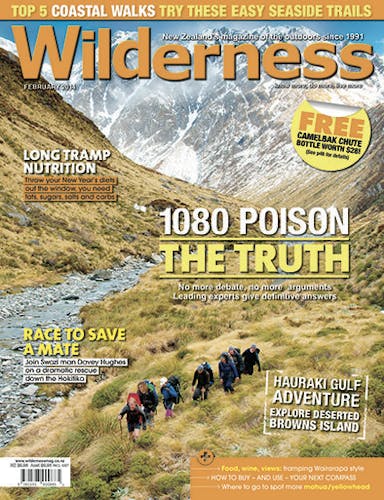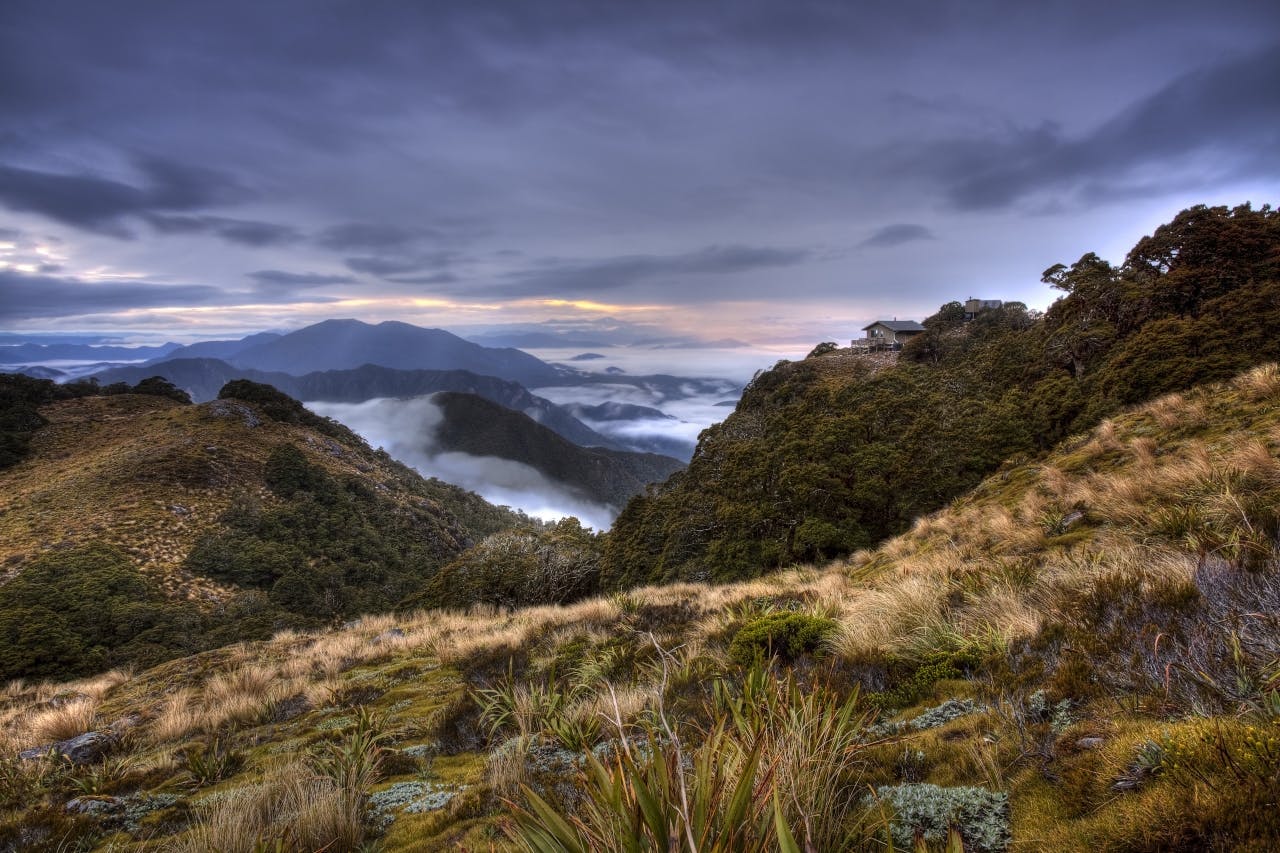- Time
- 4-5 days
- Grade
- Moderate
- Accom.
- Old Ghost Road Huts, $15/night, booking required: Lyell Saddle Hut, 11 bunks; Ghost Lake Hut, 12 bunks; Stern Valley Hut, 10 bunks; Specimen Point Hut, 14 bunks. DOC huts: Goat Creek, four bunks; Mokihinui Forks Hut, 10 bunks
- Access
- Lyell Conservation Campground on Upper Buller Gorge, SH6. Mokihinui Road-end, via Seddonville and SH67
- Map
- BR22
Ray Salisbury seizes a golden opportunity to travel the Old Ghost Road and discovers that our pioneering past is still near the surface.
After all the controversy, delays and marketing hype we have to go see for ourselves this home-grown, grass-roots community effort known as The Old Ghost Road, an 80km journey through pristine wilderness between the rugged Buller River and Karamea Highway.
With melancholic monikers such as Solemn Saddle, Suicide Slips, Lake Grim and Stern Valley, who can resist?
Old survey maps show two pack tracks punching into the remote regions of the Mokihinui watershed, but they were never linked up. The Old Ghost Road does just that, creating a through tramp; what the old diggers dreamed of is now realised.
And so, in late November, a seasoned quintet of familiar faces assembles at DOC’s campground in the Upper Buller Gorge. The Ghost Road was supposed to open earlier in 2013, and after several false starts, the tramping trail is about to open for business. We’ve booked bunks in two huts, and weatherman Jim Hickey has promised fine weather.
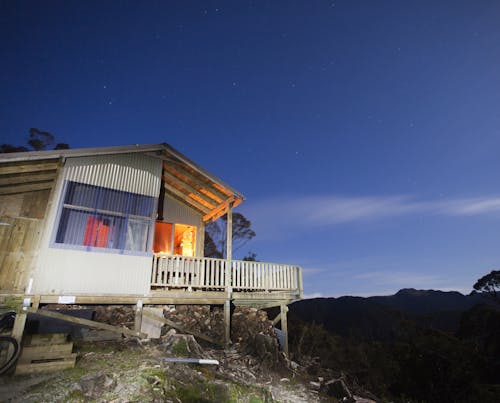
Lyell Saddle Hut looks out to the remote Glasgow Range
Someone has remarked that the Buller is a portal to another country. I reckon that DOC’s Lyell Walkway is a portal to another time. Back to the gold rush of 1865, in fact, when the main town of Lyell was sited here, in this empty clearing which, ironically, is bustling in the height of summer.
Crossing Lyell Creek on a high suspension bridge, the original dray road follows the true right, then narrows to a pack track all the way to Lyell Saddle, some 18km distant. The climb is so imperceptible, the track so well-formed, that we are clocking speeds in excess of 5km/h.
But I’m not one to rush; I like to savour the experience, especially when the sun is smiling and there are mother lodes of interesting diversions along the way. The Lyell Valley is layered with human history; the pioneering past is still near the surface.
First up is the ghost town of Gibbs, barely noticeable but for the new interpretative signage, revealing glimpses of the gold miners’ struggles. This wee metropolis sprung up in 1887 and lasted till 1912. Gibbs Town boasted a school, post office, the Belfast Hotel, and an assortment of prospectors’ cottages.
Two hour’s pleasant amble sees us arrive at the decrepit Eight Mile Hut, formerly known as the bunkhouse and now a dishevelled A-frame slunk low in the mossy forest, surrounded by artefacts such as shovel heads and rotten boots. My companions drop their packs to explore Alpine Hill, as a lone kaka flies through the canopy.
Further on, this pack track narrows to negotiate two landslides. Bikers are urged to dismount here as a precaution. We fossick around and find an old kettle and the rusted remains of more miners’ huts.
Six hours of leisurely going sees us enjoy the mod cons at Lyell Saddle Hut. It is 18 months since we’d been here, with snow on the hills and a frost on the ground. We’d organised a solitary night’s accommodation between the track workers’ six-day shifts. Since our initial visit, the men have done a sterling job clearing and cleaning the hut’s environs. Gone are the electric light bulbs, generator, gas oven, toaster and microwave. Across the clearing are twin chalets sporting the names Zala and Gibbs, ghost towns we’d passed through. Visitors can pre-book these smaller, four-berth sleep-outs.
The saddle is shrouded in mist when we wake. Nobody says much; the mood is subdued. We are away by 8am on a mission up to Ghost Lake Hut. Initially, a wide, metalled pathway leads along the saddle before starting a series of switchbacks which make for slow progress up Bald Hill. Eventually, we sidle north on to the Lyell Range. It feels invigorating to be out in the open, blown by the wind, venturing into the bleak beyond. Enchanting cloud forest gives way to dracophyllum trees. We saunter along beneath the invisible tops of Rocky Tor, the highest point on the range. The narrow track is exposed and rough underfoot. The topography is unusual, with rocky pinnacles stabbing into the mist like an ethereal Tolkien dream. I think to myself, Somewhere down there, in the clouds, is the mighty Mokihinui.
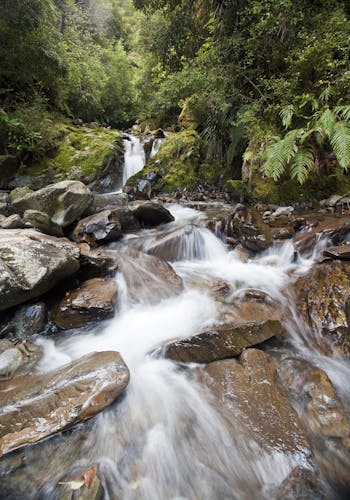
A beautiful cascade bounces down off the Glasgow tops
We skirt the summit of Mt Montgomery, and before you can say ‘Mokihinui-Lyell Backcountry Trust’, we are lighting the woodstove inside the hut. Nearby is a commodious long drop, picnic table and twin sleep-outs, named Murch and The Tor.
I text message my wife, who relays the good news: The Old Ghost Road officially opens on Monday, which gives me the impetus to be first to complete the track out to Seddonville. I merely have to wait out the storm, drinking tea and stoking the fire – simple. After dusk, I can spot the twinkling lights of Murchison, far, far below.
Sunday morning sees my companions return to their cars and work in Nelson. I am using this club trip as a sort of springboard, piggy-backing off it to launch further into the unknown. That’s what adventure is about, really. Taking a gamble, with the outcome uncertain, jumping off the cliff.
Peering off the hut balcony, I gaze into a world of white. Ghost Lake Hut is built atop a 100m bluff which is, thankfully, fenced off. An exquisite panorama is revealed below: a circular tarn of yellowy-green hue materialises from the swirling mist like an apparition. Walled in by towering crags and scattered scree slides, the alpine cirque is cloaked in tussock, snow grass, flax and a copse of beech which clings defiantly to the face. The raucous cry of a weka echoes off the mountainside, its sad soliloquy amplifying my feelings of solitary confinement. It is cold, it is wet and I am alone. As torrential rain washes the hut, I ponder how hard it was living on the West Coast in the 1880s. Back then, isolation was a huge drawback. These days it’s what people come here for.
At 6am the following morning I squelch around Ghost Lake admiring the pristine purity of this natural amphitheatre. But back inside the hut, I am plagued with indecision. Should I continue the tramp? From this point onward, there is no beaten track. In fact, there is no track at all. Only orange markers and visibility has dropped to a meagre 20m, making navigation difficult.
But after 48 hours at Ghost Lake Hut, cabin fever has set in.
I shoulder my swag and commit to completing the Road. Within five minutes my boldness is rewarded as the sun stages an appearance, suddenly saturating the colours of the landscape and giving form to its features. I waste an hour taking photographs of the unfolding grandeur, giving artistic expression to my experience of this place.
From Ghost Lake, marker poles lead me down steep snow grass slopes, then across the lake outlet creek. Marked by pink tape, a light ground trail sidles onto a ridgeline. As it climbs, the bush opens up. I revel in racing along, searching ahead for poles, crashing through scrub, up to a prominent spot height on an unnamed hill. Looking over my shoulder, I marvel at the hut and sleep-outs perched precariously on a precipice, hundreds of metres above me.
From this remote vantage, I gaze northward, recognising the profile of the Thousand Acres Plateau, with the Haystack and the Needle vaguely visible on the horizon.
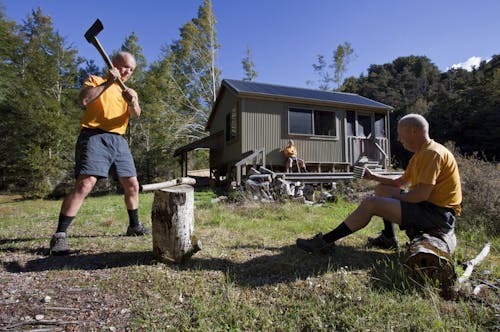
What to do with daylight? Author at Stern Valley Hut
My ridge-top ramble soon loses altitude, entering a tangle of stunted beech. Two hours after leaving the lake, I am searching for illusory track markers, my enthusiasm waning. While the route has only recently been opened up with a machete, there is no formed track underfoot. I am finding my own way over rocks, roots and rotten logs. It is likely that with more tramping traffic a ground trail will eventually evolve. Neinei gives way to a mix of podocarp and montane beech forest. I recognise rimu, totara, pepperwood and juvenile lancewood.
Finally, after four hours of hard slog, the trail spits me out into the Stern River. Typical of West Coast waterways, huge rounded boulders line the banks, and dense forest crowds in on the river. A rough, riverside route leads along to my evening accommodation.
Stern Valley Hut is well-situated at the top end of grassy flats where wild goats graze and sandflies hover. Each Old Ghost Road hut exudes a real ‘sense of place’ and has its own idiosyncrasy; touches of quirkiness that make originals, not the cookie-cutter clones we normally expect. This hut has running water on tap and the dunny sports a recycled window frame. Rustic furniture is rough-hewn, deliberately unfinished. Seats are lengths of H3 pine, nailed to tree stumps. Fortunately, all windows have fly-screens.
On my fifth day on the Road, I have a quick wash in the river. With wall-to-wall blue sky overhead, I smile to myself. Getting to the forks today shouldn’t be a problem.
I set off along the pleasant forest path. My mood is cheerful as I ascend the North Branch of the Stern, across scrubby meadows, through copses of rimu and young totara. A pair of Canada geese dominates the valley. Route markers draw me into a corridor of bracken and bush lawyer, which lacerate my forearm. My mood begins to reflect the changing terrain when I leave Stern River and skirt Lake Grim. Nearly twisting my ankle, my trekking pole bears the brunt of a fall and snaps. Trying to find a way through a boulder field, I realise it is an ancient landslide that has created the open country I am travelling through.
A hard grunt up the valley wall has me cursing at whoever designed this route. A precarious sidle along to Solemn Saddle sees me feeling very, well, solemn. The vertiginous slope is slippery, offering few footholds, so my arms are over-worked as I swing from tree to tree like a monkey. No longer tramping, this is a full-body workout.
It has taken me 2.5 hours to reach the saddle. A further 45 minutes of tricky route-finding on steep slopes finds me on a giant landslide that’s devastated the hillside. Onward through bracken and head-high scrub, lawyer rips at my flesh. I slip and slide down onto grassy river flats to arrive in Goat Creek where I spot a wild goat sun-bathing on the opposite bank.
Surely, the going will be easier now, I think to myself as I wade through a terrace of toi toi before climbing an old permolat spur track. One of the track crew had been overly enthusiastic in hanging ribbons of pink tape through the forest, leading me away from the official route.
After six hours on my feet, I finally stumble into Goat Creek Hut, an historic four-bunk shanty built back in 1957 and recently renovated. Wilma the weka is in residence along with more goats.
After signing my name on the hut graffiti wall, I force my weary body onward. This middle section of the Old Ghost Road is recommended for ‘fit and experienced trampers’. I am beginning to think that I am less of the former, and more of the latter.
A three-metre-wide mountain bike track hugs the river bank along to where an impressive swingbridge will cross the Mokihinui River, except it hasn’t yet been built. The low water level means I can happily ford this notorious river without getting my pants wet. But there are no markers, signs or obvious track on the far bank.. I resign myself to a slow but enjoyable journey down-river, fording the Moki a dozen times, staying mainly on the true right bank where flats of marram grass and thistles make for reasonable travel. Sandy beaches and boulder-hopping make somewhat slower progress, but in contrast to the confines of the jungle, I enjoy the travel through these wide open spaces.
Wading through crystal clear water into a warming headwind. I gaze in awe at the white walls of the Thousand Acres Plateau at the head of the Larrikin.
As the sun dips below the shadowy ranges, I navigate onto the new bike track, spook more goats, and stagger into Mokihinui Forks Hut before dark. My feet are swollen after nearly ten hours on my feet. Four track workers are using the restored hut as a base and feed me their leftover dinner, for which I am thankful. Sleep comes quickly.
At the crack of dawn, the men are breakfasting and cussing. When they depart on trail bikes, I cook up the last of my rations. My pack seems to weigh heavily on my shoulders as I stroll along. Here, the fertile flats were once farmed, before the 1929 earthquake flooded them, creating a temporary lake. Bleached stumps stick out of the sand like an old graveyard. From these picturesque plains, the Mokihinui turns into a monumental gorge, hemmed in by rock walls, alternating between boisterous, grade-three white-water and pools of emerald green.
The mountain bike track is graded at less than five degrees, so I am marching fast again. Reaching the hut at Specimen Point, I admire the two sleep-outs which carry the names of 1880s gold mines: Red Queen and Guiding Star. This 14-bunker has a magnificent veranda view to the Mokihinui below. It’s hard to imagine that this gorge was nearly damned. Suspended high above Specimen Creek, an impressive bridge spans the boulder-strewn river as it leaps and bounds off the Glasgow Tops, merging with the Mokihinui.
The canyon tightens and valley walls are vertical. I cautiously creep along the old pack track until it disappears into an abyss at the aptly-named Suicide Slips. In times past, intrepid trampers had to negotiate these with nerve, assisted by a steel cable. Three swingbridges now span the gaping void.
Hours float by and the dry, summer sun is beating down as I stagger into Seatonville, another ghost town that once serviced mining claims such as the Red Queen. My legs are screaming blue murder – I’ve just walked a double marathon with a heavy pack. Trackside marker posts indicate the remaining distance to journey’s end: 10km … 9km … 8km.
An especially beautiful cascade has me reaching for my camera. I fear that delightful details such as this waterfall may be missed by those racing by on rubber tyres. Six days in the backcountry has slowed me down and detoxified my soul from the need for speed.
Finally, at Welcome Creek, I pass under the Old Ghost Road gateway, hobbling along a 4WD road. Within an hour I am sipping ginger beer inside the Seddonville Hotel with the local cockies. By bedtime, I have hitchhiked home to Nelson. Clean sheets and a hot shower never felt so good.





